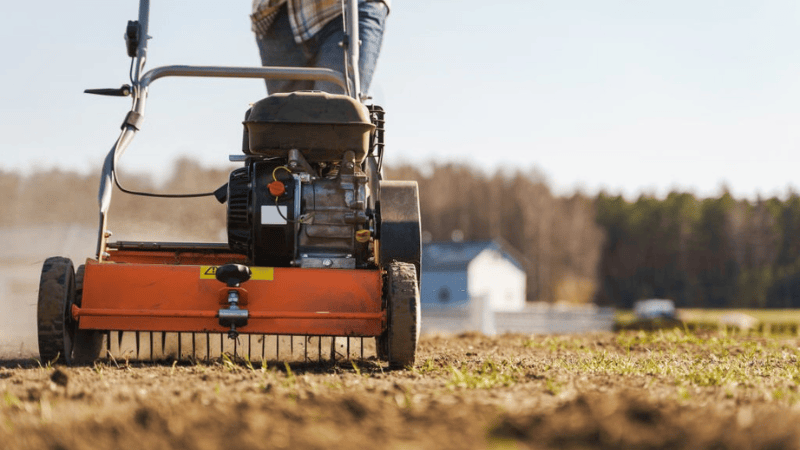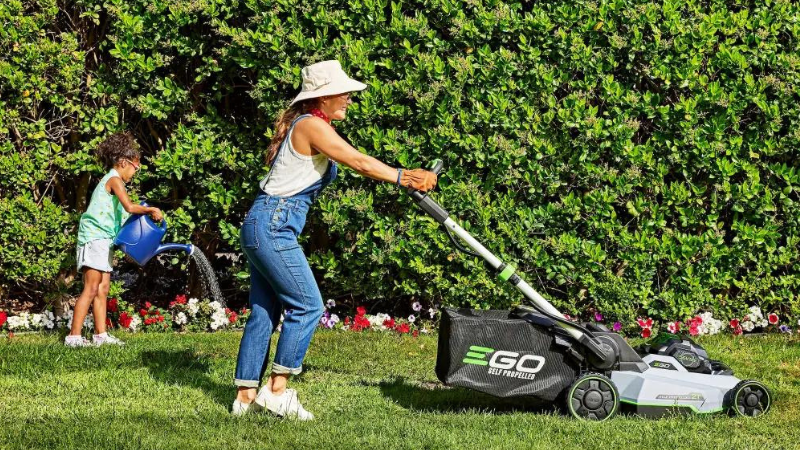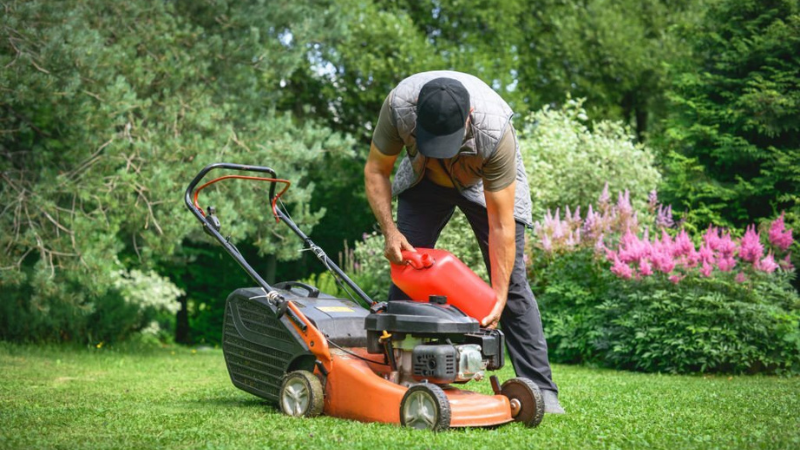Aerating your lawn helps prevent bare spots and poor grass growth caused by a lack of air and nutrients. It also prevents the soil from becoming too compact, improving the health of your lawn, especially in areas that are frequently walked on or where the soil seems too dry or too wet.
If you're in the market for an aerator for your lawn needs, below are our picks of the best lawn aerators available in Australia. We include homeowner-friendly models, battery-power models, and gas-guzzling products. Ready to explore the best lawn aerators? Let's get into it.
Our Top Picks
We understand that you may not have the time to read our in-depth research. So, here are our top three picks for a quick purchase:

Hyundai HYSC210 Aerator
Best aerator for most backyards with a 40 cm working width and 45L collection bag, powered by a 4-stroke OHV petrol engine.

Masport 42V AL-KO Aerator
Best battery-powered lawn aerator with 36 cm working width and lightweight and manoeuvrable construction for smaller gardens.

Walensee Lawn Aerator Spike
Best manual spike aerator with 15 sharp tines (5.8 cm long each) and strong iron material with rust-resistant powder coating.
Top 7 Lawn Aerators for Aussies
As an Aussie homeowner, you understand that the secret to a lush, envy-worthy lawn lies in the art of aeration. Below, we evaluate the top aerators available in Australia to help you create a greener, healthier, and more vibrant slice of paradise right in your backyard.
1. Hyundai HYSC210 Aerator & Scarifier
Best Aerator for Most Backyards

The Hyundai HYSC210 is a dual-function garden tool powered by a 4-stroke OHV petrol engine. Its 40 cm working width efficiently covers the area, and its depth settings are adjustable for versatility. The tool also has a 45L collection bag and 18 hardened steel blades for removing dead grass, thatch, and moss.
Being a 2-in-1 machine, the garden tool saves you money and time. You can easily switch between aeration and scarification. Plus, its height-adjustability, ranging from +15mm to -15mm, lets you customise the finish on your lawn, giving you complete control over the look and feel of your grass. On purchase, you get the 2-year Hyundai platinum warranty.
Pros
- 40 cm working width
- 4-strove OHV petrol engine
- 18 hardened steel blades
- Adjustable aeration depth setting
Cons
- Can be noisy when in use
2. Masport 42V AL-KO Scarifier/Aerator
Best Battery-Powered Lawn Aerator

The Masport 42V AL-KO SF 4036 is a good value aerator. It allows for seasonal scarification and features steel blades that dig into the soil to remove thatch, avoid bare patches, and ensure a healthier, oxidised lawn. The steel tines penetrate the ground, collecting debris in a 50-litre catcher bag.
The Masport lawn aerator is simple and can do two jobs: raking grass and scarifying. It's also easy to move around and isn't heavy, which makes it great for small lawns and easy to store and carry. Plus, it's the only aerator on our list that runs on a battery. Masport's battery is reusable and can be used for other Masport products. The aerator has a 4-year warranty.
Pros
- Durable and sturdy steel blades
- Lightweight design
- Battery is reusable with Masport products
Cons
- Catcher not included
- Not suitable for deep aeration
3. Bluebird Lawn Aerator 530
Best Self-Propelled Aerator

Using the plug aeration method, the Bluebird Lawn Aerator 530 digs out soil cores to allow oxygen and nutrients into the ground. The model has a generous 3-inch (or 75 mm) digging depth and a 19-inch (482 mm) operational width that boasts an efficiency of up to 2034 sqm per hour. This makes it perfect for seasonal aeration across larger garden areas, landscapes, and industrial spaces.
Bluebird's lawn aerator has thirty coring tines and a unique 2cm closed spoon design that is hardened for a robust lifespan. Its Briggs & Stratton petrol 4.0hp engine ensures a robust aerator and efficient operation. The aerator has foldable handles for convenient storage and transportation.
The Bluebird Lawn Aerator 530 comes with a one-year manufacturer warranty. However, its vibrations can be unbearable during frequent use. Therefore, we recommend it for contractors and hire and rental business owners.
Pros
- Good for large lawns or gardens
- 4.0 hp petrol engine
- Foldable handles for easy storage
Cons
- Only 1-year warranty
- Vibrates with prolonged used
4. Toro Stand-On Lawn Aerator
Best Ride-On Aerator

The Toro 30" Stand-On Aerator has an adaptable hydraulic pressure system that adjusts to different ground shapes for coring. Its Kawasaki V-Twin engine can put a massive weight of up to 544 kg on the tines to pull out plugs as long as 12.7 cm. This ensures deep aeration across a width of 76.2 cm. You can adjust the hydraulic system to get the core length you need.
Toro has a control system that's easy to use, which makes it safe and secure. It's designed to keep machine vibrations from the operation platform, making the ride smooth and comfortable. It also has electronic foot pedals that let you control when the tines go up or down. This means you can keep aerating the soil while moving the machine around.
Pros
- Large 76.2 cm aerating width
- Hydraulic pressure system enables gliding
- Up to 12.7 cm aeration depth
- Has electronic foot pedals for control
- Powerful Kawasaki V-Twin engine
Cons
- Bulky and heavy
5. Billy Goat AE1300H Hydro Aerator
Highly Productive Aerator

The self-propelled Billy Goat AE1300H 20-inch hydro aerator can aerate a quarter of an acre in 15 minutes. It is perfect for lawn care professionals who want to complete tasks quickly. The aerator's speed and operation direction are adjustable at the touch of a switch. It can travel up to 4.3 mph.
The aerator has a generous aeration width of 30 inches and Variable Aeration Density (VAD), which creates between 2 and 10 times more cores than most drum aerators in just one pass. This means you can cross your terrain only once to get work done. It also implies that patch repair and seedbed preparation can be carried out by slowing the aerator down across bare patches of lawn.
The hydro lawn aerator also features a robust Flextech arm, meaning that core depth is double the distance of most drum models, which allows for less frequent aeration. It can also reverse and turn without lifting the tines out of the ground. With 15-inch tyres and a 35-inch wheelbase, you can easily tackle rugged terrain and slopes up to 20 degrees with the hydro lawn aerator.
Pros
- Self-propelled aerator
- Great maneuverability with reverse aeration
- Can work on terrain slopes up to 20 degrees
- Aeration width of 76.2 cm
- Performs seedbed preparation
Cons
- Expensive
- A bulky machine
6. Walensee Lawn Aerator Spike
Best Manual Spike Aerator

Walensee Lawn Aerator Spike is a manual aeration tool with 15 sharp tines, each 5.8 cm long. The spikes are constructed from durable materials and penetrate compacted soil effectively. The rest of the tool is made of strong iron with a rust-resistant heavy-duty powder coating and an ergonomic handle with a rubber coating for comfortable handling.
The 15 well-spaced spikes provide an efficient, well-aerated small lawn space. However, since the spike area is only 23 cm wide, it can be laborious, especially if you have a large lawn. We recommend watering your lawn before using the lawn aerator so that it can easily penetrate the soil.
The Walensee Lawn Aerator Spike is easy to assemble. On purchase, you receive a T-handle pole, a connecting pole, a foot pedal that carries the spikes, two nuts, and two wrenches. The assembled tool is about 88 cm long, making it suitable for a medium-height or tall person.
Pros
- Has 15 strong 5.8cm tines
- Ergonomic handle with rubber coating
- Has a 23 cm aeration width
- Easy to use and assemble
Cons
- Laborious when used for a large space
- Not suitable for very compact soil
7. vidaXL Lawn Aerator for Ride-on Mower
Best Tow-Behind Aerator

The vidaXL Lawn Aerator is a tow-behind aerator attached to ride-on mowers or lawn tractors. It can reach as deep as 7.6 cm into the soil, and if you put extra weight on the top shelf, it can get even deeper into hard soil. vidaXL's lawn aerator is made from steel to withstand the rigours of lawn aeration.
With a 102 cm width, it can cover a larger area in a shorter time, making it suitable for medium to large lawns. Leveraging a ride-on mower's power for movement, the aerator is also convenient to use. Once attached to a mower, you only need to drive around the lawn.
Pros
- Decent 7.6 cm penetration
- Aeration width of 102 cm
- Convenient manual aerator
- Sturdy steel construction
Cons
- Cannot be used on its own
How to Choose the Best Lawn Aerator

To get the best out of your lawn aerator, consider certain factors before deciding. Here are three crucial details to consider:
#1 - Size of Your Lawn
The size of your lawn can significantly impact your choice of lawn aerator. A manual or handheld aerator may be sufficient if you have a smaller lawn, as it allows for greater precision and control in tight spaces. However, a powered aerator (battery or petrol) may be better with a more extensive lawn, as it can cover a larger area more quickly and efficiently.
Additionally, the terrain of your lawn can also play a role in your choice of aerator. If you have uneven or sloping terrain, a self-propelled aerator may be more suitable, as it can easily navigate these obstacles. On the other hand, if your lawn is relatively flat and even, a tow-behind aerator may be a more cost-effective option.
#2 - Type of Soil
A plug or core aerator is best if you have a heavily compacted lawn (water puddles or hard, clay soil). Plug aeration not only breaks up but also redistributes the soil. This promotes root growth and easier access to essential nutrients and water.
Consider a spike aerator for less compacted soil, such as loam or sand. Spike aeration is ideal when preparing for overseeding or creating better access to the root system for fertilisation.
To determine the type of soil you have in your lawn, grab some soil in your hand and squeeze. You will feel a gritty element if the soil is sandy or loamy. You won't be able to roll it. Instead, it will fall through your fingers. Clay soil, however, has a smearing element that is easy to roll into a desired shape.
#3 - Storage Space
Storage space is another essential factor when choosing a lawn aerator, especially if you have limited storage space. Powered aerators, in particular, can be pretty large and bulky, so it's essential to ensure that you have adequate storage space before making your purchase.
A manual or handheld aerator may be a better choice if you have limited storage space. These typically take up less space and can be easily stored in a shed or garage. Additionally, some powered aerators can be folded or collapsed for easier storage, so look for these features when evaluating your aerator.
Forms of Lawn Aeration & Aerators

There are various lawn aerating methods, ranging from aeration shoes to motorised mechanical aerators designed for larger lawn spaces. Motorised mechanical aerators are particularly well-suited for deep soil penetration and require less maintenance while offering speed and efficiency.
Mechanical aerators use two primary mechanisms: a drum, which operates through a rotating spiked cylinder, and a cam, featuring a shaft that drives spikes up and down to facilitate deeper soil penetration through plug aeration. Many people prefer cam-based models because they can extract substantial plugs and maintain stability, a feature that can be challenging to achieve with most drum-style models.
Some also favour plug aeration, where a plug of soil is removed, over spike aeration, which involves poking holes into the ground, owing to its long-lasting benefits. However, as is commonly recommended by experienced groundskeepers and lawn care experts, combining both methods is often considered the most effective approach.
How to Use a Lawn Aerator
Using a lawn aerator properly ensures that you'll maximise its benefits and maintain the health of your lawn. Here's a step-by-step guide on how to use a lawn aerator:
Step 1: Choose the Right Aerator
As mentioned, there are two main types: spike and core (or plug) aerators. The core aerator is generally preferred, especially for heavily compacted soils, as it removes plugs. Choose an aerator depending on the soil type and work at hand.
Step 2: Prepare the Lawn
Thoroughly water your lawn one to two days before aerating.
This softens the soil, making it easier for the aerator to penetrate the ground. We also advise cutting your grass to its recommended height before aerating to facilitate the process.
Likewise, before you begin aerating, use flags or other markers to indicate the positions of sprinkler heads, cable lines, or other buried utilities to avoid damaging them.
Step 3: Start Aeration
If you're using a manual aerator, step onto it using your weight to drive the spikes or tines into the soil. For a mechanical aerator, start the machine like a lawn mower, then begin at one corner of the lawn and proceed in straight lines. This ensures even coverage.
Overlap your paths slightly to ensure no patches are missed, especially for heavily compacted areas or thick thatch. Make your second pass perpendicular to the first to ensure even coverage. But do not overdo this, as this can damage your soil quality and affect lawn and plant growth.
Step 4: Water the Lawn
After you aerate your lawn, it's a good idea to water it well. This helps push essential nutrients down into the soil. This is also a great time to add grass seed or fertiliser to your lawn. The holes from the aeration make it easy for the seeds and nutrients to penetrate the soil.
Step 5: Clean the Aerator
If you've rented or own a mechanical aerator, clean it thoroughly after use to remove soil and grass buildup. This ensures it will work efficiently the next time.
Depending on your lawn's needs, you might need to aerate once or every other year. Heavily used lawns or those on heavy clay soil might benefit from more frequent aeration.
5 Benefits of Lawn Aeration

Lawn aeration helps roots grow deeply and produce a stronger, more vigorous lawn. Other main reasons for aerating your lawn include:
- Aerating allows oxygen to reach the grassroots, which enhances root growth and improve overall turf health.
- Compacted soil restricts the movement of water, nutrients, and air, which can stifle root growth. Aeration removes this compaction.
- With less compaction, nutrients from fertiliser can reach the roots more effectively.
- Moderate thatch can be beneficial, but when tooo thick, it hinders water and nutrient penetration. Aeration helps break down excessive thatch.
- If overseeding is part of your lawn care strategy, aerating beforehand can improve seed-to-soil contact and germination rates.
Scarifying (Dethatching) vs. Aerating
Both aeration and scarifying (also known as lawn scarification) are crucial lawn maintenance practices that enhance the health and appearance of your lawn. They serve different purposes but can sometimes be mistaken for one another because of their similar-looking processes. Here's a breakdown of aeration versus scarifying:
The primary goal of scarifying is to remove thatch and moss from the lawn. Thatch is a layer of organic debris, including dead grass, roots, and other plant material, that can build up between the green grass on top and the soil underneath. This is best done when the lawn is actively growing to allow it to recover quickly, typically in early spring or early autumn.
Scarifiers, also known as lawn dethatchers, use a set of rotating blades or tines that cut into the thatch layer and pull it to the surface. The removed debris is typically raked up and collected for disposal or composting.
Lawn Scarification vs Aeration: Key Differences

Here are the key differences between lawn aeration and scarification:
- Primary Purpose: Aeration is mainly to alleviate soil compaction and improve air, water, and nutrient movement in the soil. Scarifying, on the other hand, is primarily for thatch and moss removal.
- Equipment: Aerators create holes in the ground, either by pushing spikes into the soil or by removing plugs. Scarifiers use blades or tines to cut into and pull up the thatch layer.
- Frequency: Aeration might be done annually or every other year, depending on the lawn's needs. Scarifying is typically less frequent, done only when there's a significant buildup of thatch or moss.
- Thatch Layer: If you have a thick layer of thatch (over half an inch), dethatching is necessary. While aeration can help control thatch, excessive thatch may need to be physically removed using a dethatcher.
- Soil Compaction: If your soil is compacted, aeration is the preferred method. Compacted soil restricts the growth of grassroots and reduces the movement of air, water, and nutrients.
- Timing: Both scarifying and aerating are best done during the growing season when the grass can recover quickly. This usually means spring or early fall for cool-season grasses and late spring through early summer for warm-season grasses.
- Post-Procedure Care: After both scarifying and aerating, it's a good idea to water the lawn and possibly overseed and fertilise, as both procedures can be a bit stressful for the grass.
To summarise, while scarifying and aerating target different issues within a lawn, both practices are essential for maintaining a healthy and vigorous lawn. Evaluate your lawn's specific needs to determine which procedure is appropriate, or if both are required, to ensure optimal health and growth.
Frequently Asked Questions (FAQs)
Here are some frequently asked questions on the use, maintenance, and types of Aerators in Australia.
Is a spike or plug aerator better?
Spikes or plug aerators both allow you to poke holes into your lawn. However, spike aerators are not as good as plug models. Plug aerators remove material from your lawn space that creates channels for water, nutrients, and air to get down to the subspace while relieving compaction.
With spike aerators, you end up compacting the soil further, making it even harder. However, there are a few circumstances that may be just fine using a spike aerator. Such as when dealing with sandy or loamy soil or when you need to get moisture deep into the ground.
Does a lawn aerator really work?
Yes, lawn aeration is one of the most effective solutions for compacted soil. It helps loosen the soil, bringing water and essential air to the roots. In addition, aeration prevents thatch buildup and helps create a very friendly environment for beneficial microorganisms.
Should the lawn be wet or dry when aerating?
Always ensure the soil is moist to get the best results. But ensure the lawn isn’t excessively wet. For the season, spring is the most ideal time to aerate your soil. You can also aerate in the fall. But lawn aeration during the summer is not advisable because the heat will dry out the ground.
How deep should I aerate my lawn?
In most cases, aeration holes are spaced 5 to 15 cm apart and 2.5 to 15 cm deep. These estimations depend on the type of lawn aerator you are using. The optimal amount of holes per square foot can be around 24 for plug aeration, but this varies depending on the size of the hole.
If you are using a handheld tool like a yard butler that pokes 1/2-inch diameter holes. Then it’s going to take twice as many holes to remove the same amount of compaction as it is for a larger tow-behind aerator.
Is too much aeration bad for my lawn?
Yes, too much aeration can be bad for your lawn. When you aerate your lawn, you are essentially creating holes in the soil, which can leave your lawn more vulnerable to damage from foot traffic, drought, and other stressors. Additionally, excessive aeration can disrupt the natural balance of microorganisms in your soil, which can further harm your lawn's health.

And That's It!
To simplify choosing a lawn aerator, this guide categorised all handpicked options to make decision-making easier. First, evaluate your use case and requirements, then select an aerator that meets these requirements.
A good overview of what you expect from the product can help you make an informed decision that meets your unique needs. Let us know in the comment section if you have any questions.








